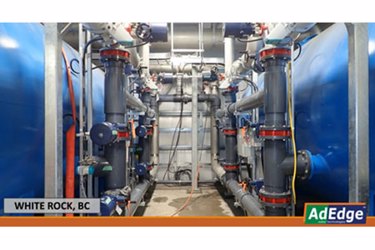Tackling Arsenic With A Cost-Effective Strategy

Arsenic presents a wide array of negative health impacts, which is why it is such a big concern for many municipal water systems. The contaminant is linked to multiple types of cancer — including bladder, lungs, skin, kidney, and liver, among others — and is known to cause of variety of other problems such as skin issues and intestinal issues.
Removing arsenic from source water can be an expensive and tedious process. Anion exchange treatment technologies, for example, produce a brine/contaminant discharge and only have an affinity for type V arsenic, while reverse osmosis solutions generate a concentrated arsenic reject and potentially hazardous ‘dumping’.
By comparison, the only cost of a properly designed iron-based adsorption system is periodic media changeout supported by innovative media.
Examining The Options
When it comes to EPA maximum contaminant levels (MCLs), arsenic is categorized as a primary MCL list contaminant because of its hazardous effects on health (0.01 mg/L).

When arsenic rates are high, but iron and manganese rates are low, adsorption is likely the best approach with the lowest capital and operating costs. Bayoxide® E33 Arsenic Adsorption Media from AdEdge is suitable for this type of application, which reduces up to 99 percent of total arsenic, including type III and type V. This iron-based media, made of granular ferric oxide (GFO), has a natural kinetic affinity for arsenic as well as other heavy metals, such as lead, antimony, and uranium, making it the most efficient and user-friendly adsorption media for the application in many situations.
Bayoxide E33 has a proven and broad pH range of 5.5 to 8.5 — with greatest performance in the 6.0 to 7.5 range — and can offer an ideal solution for any water operation that relies on a well, including small municipal systems and housing developments to individual homeowners and businesses. While it requires an oxidant, Bayoxide E33 only needs backwashing every 45 to 60 days. This is much more efficient than typical filtration media.
The parameters that have the largest impact in determining Bayoxide E33 capacity are pH, arsenic levels, o-phosphates, and silica. Overall water quality factors include iron, manganese, and hardness levels, which in many cases can be reduced or removed with a water softener. Higher levels of iron and manganese — which will foul any media bed — require a dedicated filter utilizing medias that are facilitated by oxidizers, such as ozone, sodium hypochlorite, hydrogen peroxide, or potassium permanganate. All these oxidizers are not only compatible with Bayoxide but further enhance the performance as these begin the conversion of type III arsenic into type V, which is much easier to collect.
In some cases, anion resin has been placed ahead of the Bayoxide E33 as a low-cost alternative for lowering pH, as well as reducing type V arsenic. However, special considerations must be accounted for, including the volume of sulfides present, and the length of time between regeneration must be calculated to control the pH level.
The objective is that the more contaminants and competing ions that can be removed prior to the Bayoxide E33 system, the better the media will perform. This translates to a longer media life.
By comparison, using coagulation/filtration (C/F) to treat arsenic requires an oxidant, just like an adsorption system, but also a coagulant. This allows arsenic and iron to create a floc that can be removed in a sand filtration bed. Optimal pH is also necessary to prevent iron breakthrough. As a result, C/F treatment comes with moderate capital and operating costs. Residuals management is essential, so any C/F system must be automated to account for frequent backwashes.
Case Studies
Here are several water utilities that were looking to address their arsenic problem and found success with AdEdge treatment systems:
Bakersfield, California — A 1,000-gpm flow rate with 0.012 mg/L arsenic and 8.7 pH levels.
A Bayoxide E33 system was installed that consisted of two vessels of 96-inch diameter and 60-inch sidewalls. Because arsenic levels were relatively low, the system was designed to blend 500 gpm of treated water with 500 gpm of untreated water and still get contaminant levels to below the limit. This allowed the size of the system to be cut in half.
White Rock, British Columbia, Canada — A 2,750-gpm flow rate with 0.007 mg/L of arsenic and 0.12 mg/L of manganese.
Although arsenic was below legal limits, the water treatment system wanted to reduce contamination even further. Because there were two contaminants of concern, the project was designed in stages. AdEdge ADGS+, also known as coated sand, was installed first to treat manganese, followed by the Bayoxide E33 stage to treat arsenic. Treated water from one vessel is used to backwash the other vessel.
San Antonio, Chile — A nearly 8,000-gpm flow rate with extremely high arsenic levels (0.026 mg/L) and elevated pH (8.3).
Because the arsenic MCL in Chile is lower than in the U.S., even more treatment than typical was required. ADGS+ removed about 75 percent of the arsenic, followed by Bayoxide E33 as a polishing step to get arsenic to acceptable levels.
